Oscillation of Dzyaloshinskii–Moriya interaction driven by weak electric fields
Runze Chen(陈润泽), Anni Cao(曹安妮), Xinran Wang(王馨苒),3, Yang Liu(柳洋),Hongxin Yang(杨洪新), and Weisheng Zhao(赵巍胜),2,3,†
1Fert Beijing Institute,MIIT Key Laboratory of Spintronics,School of Integrated Circuit Science and Engineering,Beihang University,Beijing 100191,China
2Hefei Innovation Research Institute,Beihang University,Hefei 230013,China
3Beihang-Goertek Joint Microelectronics Institute,Qingdao Research Institute,Beihang University,Qingdao 266000,China
4National Laboratory of Solid State Microstructures,School of Physics,Collaborative Innovation Center of Advanced Microstructures,Nanjing University,Nanjing 210093,China
5Beijing Microelectronics Technology Institute,Beijing 100076,China
Keywords: Dzyaloshinskii–Moriya interaction,weak electric field control effect,Rashba spin–orbit coupling,interfacial orbital hybridization
1.Introduction
In recent years, with the booming development of spintronic devices, more efficient methods are required to improve storage density, reduce power consumption, and enhance stability.[1–3]It has been realized that voltage-controlled magnetic anisotropy(VCMA)combing with spin–orbit torque(SOT) can be a promising manipulation to decrease the critical switching current for both in-plane and perpendicularly magnetized magnetic tunnel junctions (MTJs) in magnetic random-access memory(MRAM).[4–6]Similarly,with the assistance of the electric (E) field, the domain wall (DW) motion in race-track devices could also be improved.[7]Electrical control of magnetism seems to have great potential for various spintronic applications.Dzyaloshinskii–Moriya interaction (DMI), as one of the key ingredients for magnetic skyrmions and chiral domain walls (DWs),[8–13]arises from the presence of spin–orbit coupling (SOC) and inversion symmetry breaking system.Recent studies suggest that the Rashba effect, which is sensitive to the interfacial potential, can contribute to the DMI at the ferromagnet/oxide interface, thereby providing the possibility of externalE-field control over DMI.[14–16]Pieces of experimental evidence have been reported that the DMI energy can be linearly changed in Ta/FeCoB/TaOxstacks[17]and in MgO/Fe/Pt multilayers by hundreds of volts gate-voltage.[18]Meanwhile, groups of research on the dynamics of skyrmion controlled through gatevoltage have been demonstrated[19–21]and were suggested to be of relevance in the field of neuromorphic computing[22,23]as well as electrical logic devices.[24]However, the general trend of DMI energy over electric field remains elusive,especially for weakE-field, which is closely related to the magnetoresistance detection and electronic device applications.Without a thorough understanding of VCDMI, further applications of electric field on the system of skyrmion, STT, and SOT would be incomplete and doubtful.
In this paper, we carried out BLS measurements on Pt/Co/MgO samples applied with electric field from 10-5V/nm to 10-2V/nm.The trends of DMI energy were observed fluctuating about 15%–30%of its original value with a weakE-field.To confirm the experimental results, we obtained the theoretical DMI strength throughab initiocalculations and achieved results consistent with experimental observations, particularly in response to the weak voltage-induced DMI fluctuations.Moreover,based on the Rashba model,we explained the behavior of DMI under the weak voltage through calculations of the Rashba SOC energy source and the corresponding SOC orbital hybridization matrix at the Co/MgO interface.
2.Results and discussion
By using magnetron sputtering at room temperature,we grow Ta(3 nm)/Pt(4 nm)/Co(tCo)/MgO(2 nm)/SiO2(5 nm)samples shown as in Fig.1(a),withtCovarying from 1.5 nm to 2.3 nm.The base pressure of our ultrahigh vacuum deposition system is around 3×10-8mbar (1 bar=105Pa).The substrates we use are silicon plates with 100-nm thermal silicon oxide layers.It has been proved in our previous studies[25,26]that an inserted dusting layer between Co and MgO can prevent the deterioration of the Co/MgO interface during the deposition process, thus we also use Ta and W, as a 0.2-nm inserted layer X between Co and MgO, to improve the crystallization for both ferromagnetic and insulating layers.The top SiO2layer prevents the film from air-passivation.After the deposition,the thin films were fabricated into 2-mm stripes with perpendicular top electrodes, as we introduced in supporting information part I.
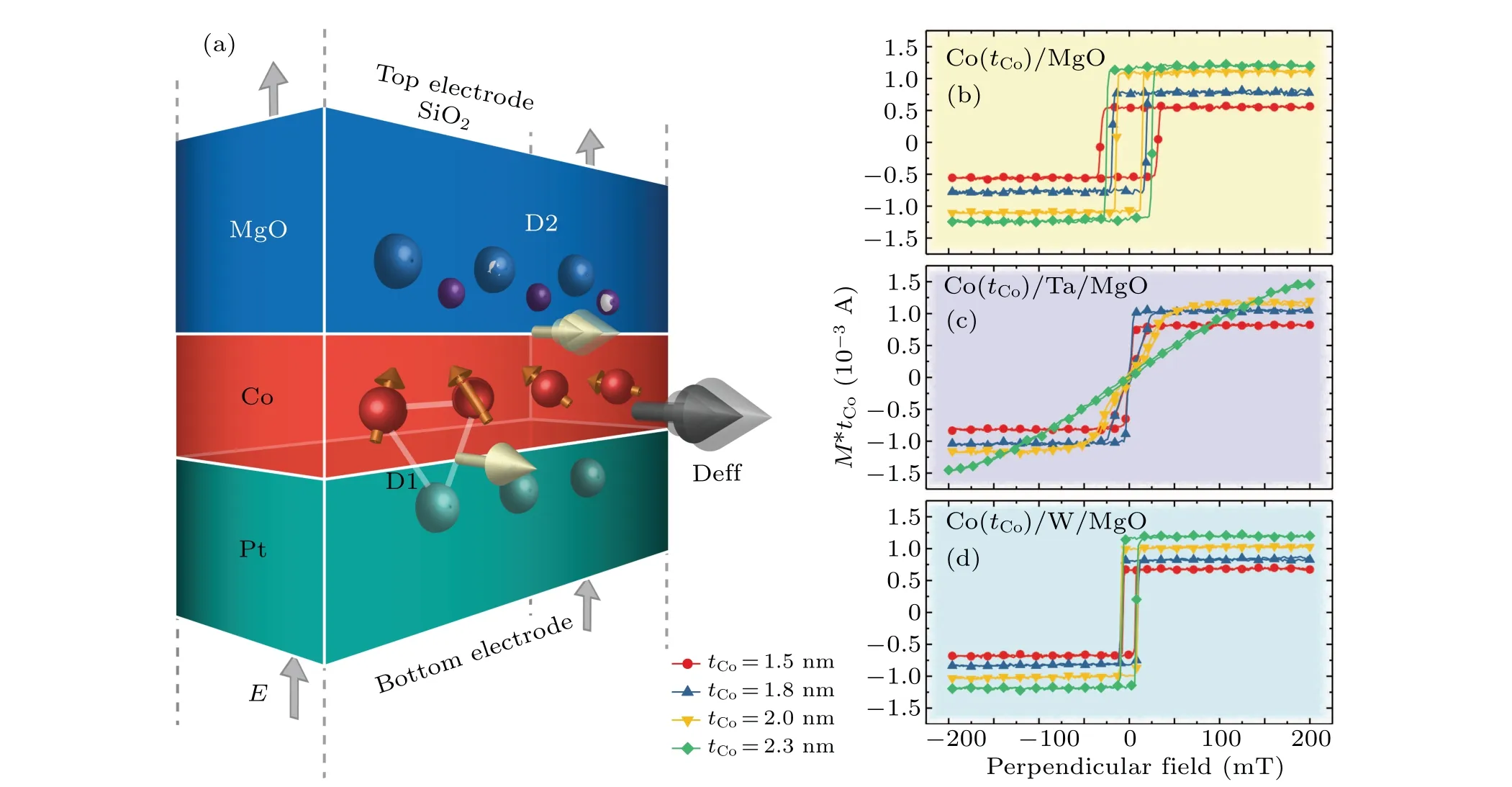
Fig.1.(a) An illustration of VCDMI in Pt/Co/MgO system.Hysteresis loops with perpendicular magnetic field for (b) Pt/Co(tCo)/MgO,(c)Pt/Co(tCo)/Ta/MgO,and(d)Pt/Co(tCo)/W/MgO.
We measured the hysteresis loops of our samples using a vibrating sample magnetometer (VSM).As shown in Figs.1(b)–1(d),except for Pt/Co(2.0 nm and 2.3 nm)/Ta/MgO,all the other samples exhibit clear perpendicular magnetic anisotropy(PMA).Loops with the in-plane field can be found in supporting information part II.By comparing the same color(sametCo)loops shown in Figs.1(b)–1(d),we found that samples without an inserted layer exhibit almost the smallest saturated moment,while the largest saturated moment appears in samples inserted by Ta,indicating the thinnest magnetic dead layertdeadwith the same Co thickness.All of the structures were annealed for half an hour at 300◦C and 350◦C.We analyzed the magnetic properties and dead layer of these samples in supporting information part III.
We quantified the strength of DMI for our sample employing a BLS set-up.It is ideally suited for studying the DMI of Pt/FM multilayers thanks to its sub-GHz resolution and few nm surface sensitivity.[27]As shown in Fig.2(a), taking Pt/Co(1.5)/Ta/MgO as an example, when the angle between incident light and interface normalθ=50◦, after fitting the Stokes and anti-Stokes signals by Lorentzian function,the frequency difference ∆fcan be obtained.By varying the angleθof the incident light,we have results of different wave vectorskaccording tok=4πsin(θ)/λ,[28–30]as shown in Fig.2(b).Hereλis the wavelength of the incident light.Furthermore,the DMI energy can be obtained by ∆f=(2γD/πMs)k.[31,32]By takingγ/2π=31 GHz/T[33]andMsmeasured by VSM into this equation,the DMI energyDcan be calculated.Note that the chirality of our Pt/Co/MgO system is inverted with respect to Ta/CoFeB/MgO in which theDvalue measured by BLS is positive.[28]The results ofDfor samples in different annealing states can be found in supporting information part IV.
We appliedE-fields ranging from 10-5V/nm–10-2V/nm on our devices and measured the DMI energyDby the method introduced above.A selection of results is shown in Figs.2(c)–2(f).At higher electric field (≥10-2V/nm), we find linear trends with a slope of typically-0.2 mJ/m2per V/nm.However, much more surprisingly, we find that the DMI energies oscillate at a low electric field (<10-2V/nm).For samples with differenttCoas well as inserted layers, the amplitude of the oscillations varies by 0.1 mJ/m2to 0.2 mJ/m2,corresponding to 14% to 29% of its original value.All of the samples exhibit such vibration part ofD,which could prove the generality of this phenomenon.
First-principles calculations are employed to confirm and explain the trends ofDover theE-field.The crystalline structure of the MgO(3 monolayers)/Co(3 monolayers)/Pt(3 monolayers) is illustrated in Fig.3(a), with the MgO surface passivated by hydrogen at the bottom side, and a 15-˚A vacuum layer on the top side.We applied the electric field along thez([001])direction from insulator to heavy metal by placing a dipole layer in the middle of the vacuum region.[34]More details about the calculation are introduced in supporting information part V.Note that we adopt a positive DMI representing CW(right-handed)chirality and a negative DMI representing ACW (left-handed) chirality.The microscopic DMI strengthdtotand micromagnetic DMI coefficientDtotas a function of theEMgOare presented in Fig.3(b).EMgOindicates the actual potential difference over the oxide layer.In the absence of an electric field,the interfacial microscopic DMI strengthdtotof the structure is-5.03 meV corresponding to the micromagnetic DMI coefficientDtotof-7.24 mJ/m2,which is consistent with the results reported in Ref.[35].Following, we found a strong oscillation of DMI in the MgO/Co/Pt structure relative to the electric field within the range of a small scale.However,when we increase the order of the electric field, the DMI of the structure varies linearly with the electric field,as shown in Fig.3(b).When a positive(negative)electric field is applied,the absolute value of DMI energy increases(decreases),which is consistent with both the experimental and the calculation results reported by others.[35,36]The trend of DMI we obtained fromab initiocalculations agrees well with our experimental results.
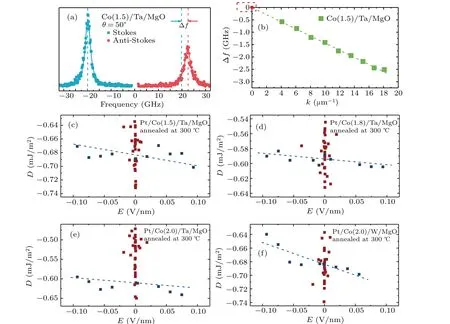
Fig.2.(a)BLS spectra for spin waves of DE mode.(b)The linear dependence of ∆f on k.Experimental results of voltage-influenced DMI for(c)Pt/Co(1.5)/Ta/MgO,(d)Pt/Co(1.8)/Ta/MgO,(e)Pt/Co(2.0)/Ta/MgO,and(f)Pt/Co(2.0)/W/MgO annealed at 300 ◦C.
To gain an insight into the origin of the trend of the DMI magnitude relative to the electric field, we plot the potential difference at the MgO/Co interface ∆EMgO-Coand the Co/Pt interface ∆ECo-Ptas a function of the electric fieldEMgO,respectively, as shown in Fig.S7 in supporting information part V.We observed that as the external electric field varies,the potential difference at the MgO/Co interface shows alterations, while that at the Co/Pt interface remains nearly constant.This highlights the MgO/Co interface as the primary factor shaping the behavior of VCDMI, directing our further analysis toward understanding its pivotal role.
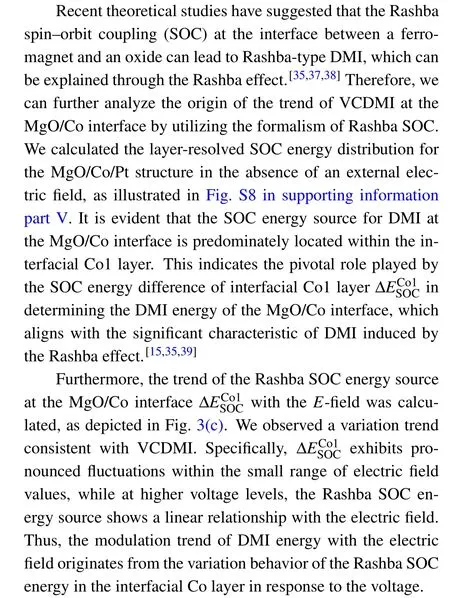
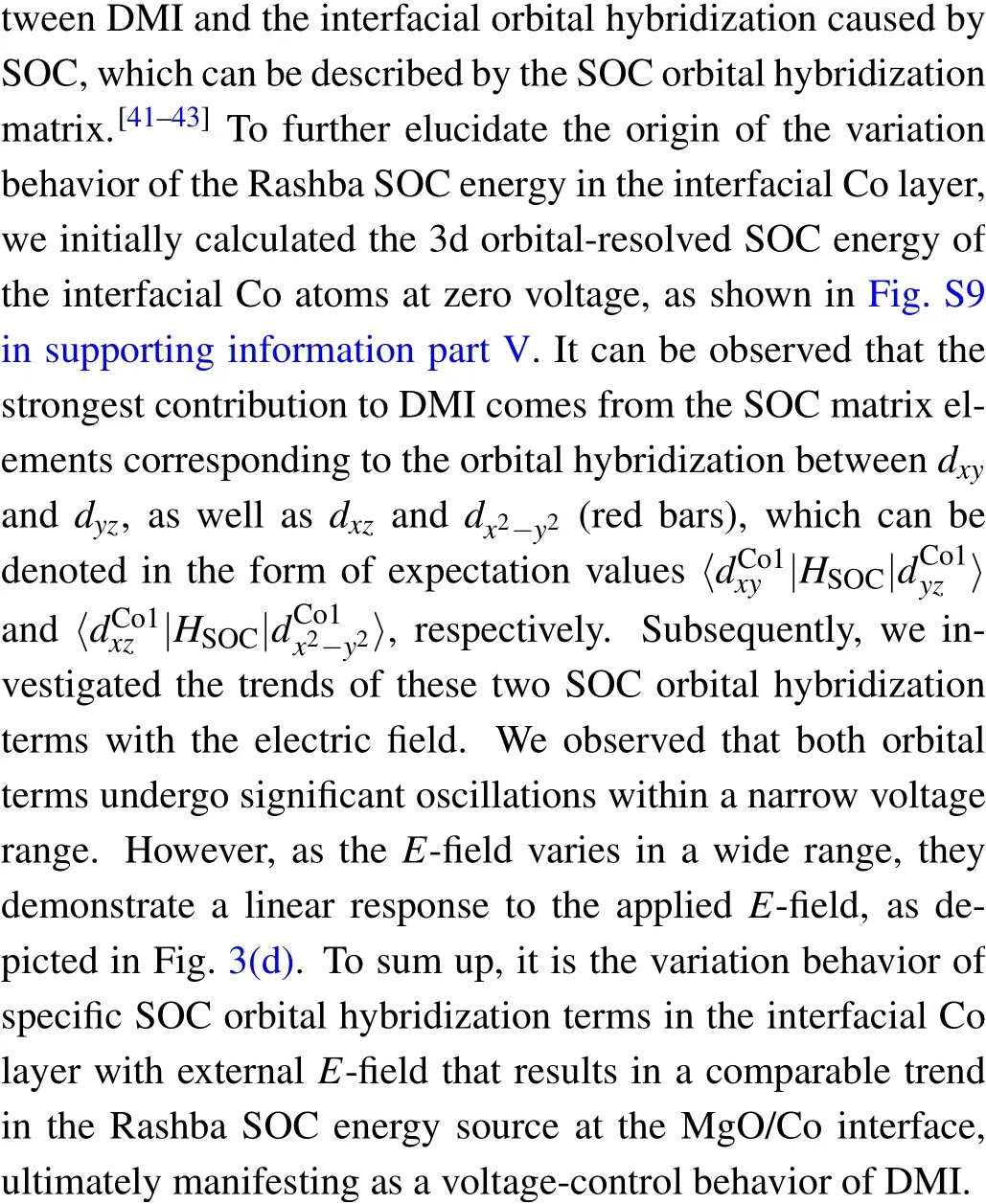
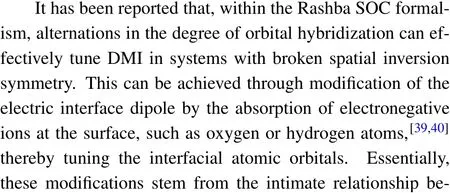
3.Conclusion
In conclusion, we experimentally found a considerable oscillation of DMI with a weak electrical field in a series of samples, and theoretically confirmed the trend throughab initiocalculation.The variation in the Rashba SOC energy source at the MgO/Co interface, more fundamentally,the change of the degree of SOC orbital hybridization at the interface is responsible for the fluctuation of DMI with the weak electric field,which is often neglected in most research.Hence,the surprising behavior of VCDMI we found refreshes the traditional perception of modulation by an electrical field and processes the guiding significance for studies on voltage control of skyrmion’s motion as well as the STT and SOT systems assisted by VCMA.
Supplementary material
See the supplementary material for details on fabrication of device,in-plane hysteresis loops,analysis of magnetic properties, DMI strength of samples in different states, and firstprinciples calculations.
Acknowledgements
Project supported by the National Natural Science Foundation of China (Grant Nos.61627813, 62204018, and 61571023), the Beijing Municipal Science and Technology Project (Grant No.Z201100004220002), the National Key Technology Program of China(Grant No.2017ZX01032101),the Program of Introducing Talents of Discipline to Universities in China (Grant No.B16001), and the VR Innovation Platform from Qingdao Science and Technology Commission.
- Chinese Physics B的其它文章
- Unconventional photon blockade in the two-photon Jaynes–Cummings model with two-frequency cavity drivings and atom driving
- Effective dynamics for a spin-1/2 particle constrained to a curved layer with inhomogeneous thickness
- Genuine entanglement under squeezed generalized amplitude damping channels with memory
- Quantum algorithm for minimum dominating set problem with circuit design
- Protected simultaneous quantum remote state preparation scheme by weak and reversal measurements in noisy environments
- Gray code based gradient-free optimization algorithm for parameterized quantum circuit

